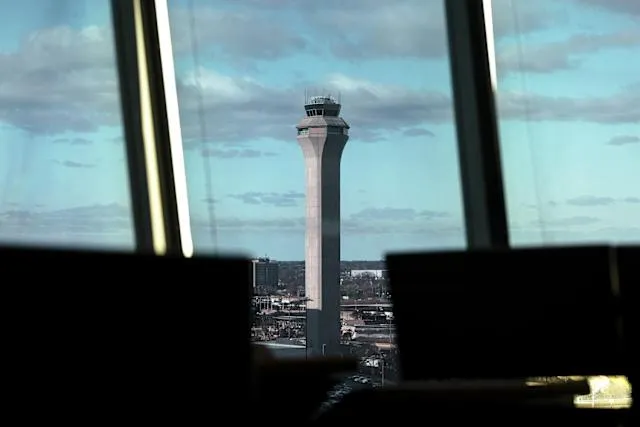Introduction
As aviation traffic in the United States skyrockets, the Federal Aviation Administration (FAA) has announced the launch of a new air traffic control system designed to better manage the increasingly busy skies. This initiative aims to enhance safety and efficiency, addressing the growing concerns of delays and operational issues that have plagued the system. Former President Donald Trump has taken to the podium to advocate for the necessity of such modernization, criticizing Transportation Secretary Pete Buttigieg for his handling of the situation.
The Need for Modernization
The announcement of this new air traffic control system comes at a crucial time when air travel is on the rise again post-pandemic. With more flights, greater passenger volumes, and an ever-growing fleet of aircraft, the current air traffic framework is beginning to show its age. As travelers experience delays and flight cancellations at increasing rates, the urgency for a revitalized air traffic control system has never been more pressing.
According to data from the Bureau of Transportation Statistics, airlines have been grappling with operational disruptions, leading to frustrated passengers and airline personnel alike. The FAA’s new system promises to leverage cutting-edge technology to streamline operations, reduce congestion in busy airspaces, and implement a more effective communication pattern between pilots and air traffic controllers.
Trump’s Perspective on Aviation Infrastructure
Donald Trump’s approach to American infrastructure during his presidency heavily revolved around pledges of ‘rebuilding and modernization.’ His recent comments on the new air traffic control system highlight his ongoing commitment to infrastructure debacles, particularly in the aviation sector. In a formal statement, Trump remarked, “America deserves a state-of-the-art air traffic control system that is as modern as the aircraft flying in our skies. It’s time to get serious about our aviation infrastructure; we can no longer afford to let it lag behind other countries.”
Trump has not hesitated to redirect criticism toward Buttigieg, asserting that the current Transportation Secretary lacks the necessary vision and understanding to tackle the pressing issues facing air travel today. In a recent press conference, he stated, “When it comes to handling our skies, the current administration clearly has no clue. We need leaders who recognize the importance of these systems, not those who are out of touch with the everyday American.”
The Features of the New Air Traffic Control System
The FAA’s new air traffic control system promises several groundbreaking features aimed at improving the efficiency and safety of air travel. Among them are:
- NextGen Technology: Incorporating satellite-based technology to provide more accurate tracking of aircraft movement and better manage airspace.
- Enhanced Communication: A shift towards digital communication methods to reduce miscommunication and improve situational awareness for controllers and pilots.
- Data-Driven Decision Making: Using data analytics to predict air traffic trends and develop responsive protocols to manage congestion effectively.
- Integrated Safety Protocols: Implementing state-of-the-art safety measures designed to mitigate risks, enhancing the overall safety of both passengers and flight crew.
These advancements are expected to result in smoother operations and potentially yearly savings in operational costs for airlines, which can be redirected to improvements for passengers.
Challenges Ahead
Despite the optimism surrounding the launch of this new air traffic control system, significant challenges remain. The implementation of new technologies invariably comes with a learning curve—both for air traffic controllers and pilots. Transitioning from traditional systems to a modernized framework can lead to temporary disruptions as personnel adapt to new methods of operation.
Furthermore, the plan’s success depends on strategic funding and bipartisan support within Congress. As political divisions deepen, securing the necessary budgetary allocations for infrastructure initiatives is becoming increasingly challenging. Critics worry that unless both parties come to the table, the plan may suffer delays or inadequate implementation.
Public Reaction and Expert Opinions
The public reaction to the FAA’s announcement and Trump’s comments has elicited a mixed response. Frequent flyers and advocates for air travel reform have warmly welcomed the prospect of modernization. Many commend the vision and urgency that Trump has brought to the conversation, while others remain cautious about over-promising and under-delivering.
Experts in aviation policy have weighed in, emphasizing the necessity of modernizing outdated systems while warning against political grandstanding. Dr. Sarah Nelson, an aviation policy analyst, stated, “We absolutely need a proactive approach to these systems, but it should not become a political weapon. The real focus should be on safety and efficiency rather than partisanship.”
The Role of Innovation in Air Traffic Control
Historically, air traffic control has evolved consistently, yet the pace of technological advancement has begun to accelerate in recent years. Innovations like artificial intelligence (AI), machine learning (ML), and cloud computing are playing a pivotal role in rethinking how air traffic controllers manage activities in the sky.
The new air traffic control system is expected to integrate many of these technologies. For instance, AI can analyze flight patterns and predict delays, allowing controllers to reroute flights before congestion occurs. Machine learning algorithms can enhance decision-making by learning from historical data and improving operational protocols over time.
The Future of Air Travel
The FAA’s ambitious air traffic control overhaul marks a significant milestone for the future of air travel in the United States. While skeptics remain vigilant, the potential for a smoother, more efficient travel experience is now on the horizon. With the looming specter of Biden administration policies and Trump’s criticism, the landscape of air travel reform is charged with compelling narratives.
Ultimately, whether this initiative successfully takes flight will depend on bipartisan political will, a commitment to safety, effective integration of new technologies, and a collaborative effort between aviation authorities and the traveling public.
Conclusion
The FAA’s announcement of a new air traffic control system is a decisive step towards modernizing America’s aviation infrastructure. While former President Trump’s critiques set a charged tone, they underscore a vital conversation about infrastructure reform in America. As the skies grow busier, innovation in air traffic control is not merely a luxury; it is an essential investment in the future of safe and efficient air travel.







